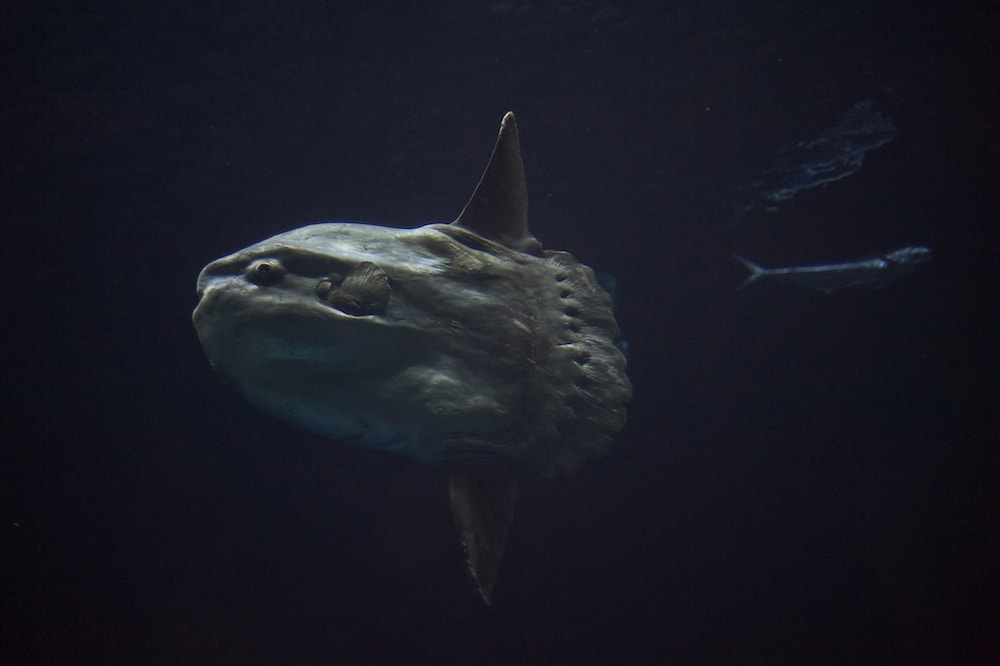Invasion Of The Jellyfish
8:56 minutes

Consider this prediction: Jellyfish and other adaptable, gelatinous animals could multiply and multiply and multiply until they dominate the seas and fill vacated ecological niches…to the detriment of some fish species, and even human infrastructure. Nope, it’s not a scene from a movie. As oceans warm and overfished food chains collapse, a very slimy future may be in store for the seas. China is even working on jellyfish “shredders” to help protect aircraft carriers from tangles of the gooey invaders, which can get stuck in intake pipes and clog machinery.
Meanwhile, the populations of one jellyfish predator—the gawky and threatened ocean sunfish—are higher than expected off the coasts of western Europe. Sunfish in that area eat as much as 20,000 metric tons of jellyfish per day. Could this mean the jellyfish are indeed taking over?

Writing for Current Biology, a team of researchers describe how the ocean sunfish may be doing well thanks to rising jellyfish populations. David Gremillet, one member of the research team, explains why tracking sunfish—easier than counting jellyfish—could help scientists around the globe monitor where and to what degree the predicted “rise of slime” is occurring.
David Gremillet is an oceanographer at the Center for Functional and Evolutionary Ecology at the National Center for Scientific Research in Montpellier, France.
IRA FLATOW: Now we’ve just talked about one possible consequence of a warming ocean, and that is more stress for animals like narwhals. But have you heard of another possibility, the so-called rise of slime? Now picture an ocean where jellyfish have taken over as overfishing and warming waters knock out some of the large fish that normally prey on them. Who cares?
Well, just last week came news that China is working on jellyfish shredders to protect aircraft carriers from these blobby invaders that might get caught in valves. And if you’re not interested in eating jellyfish, you might not enjoy the fisheries of the future.
My next guests’ research suggests that the slime is indeed rising, at least in parts of the ocean, as evidenced by the proliferation of one giant, weird-looking fish that loves to eat them. Here to explain is David Gremillet, an oceanographer for the Center for Functional and Evolutionary Ecology at the National Center for Scientific Research in Montpellier, France. He’s co-author of new research published this week in Current Biology. Welcome to Science Friday, David.
DAVID GREMILLET: Good evening.
IRA FLATOW: Good evening to you. Let’s talk about this. Let’s start with the rise of slime. Why are jellyfish predicted to take over the oceans?
IRA FLATOW: Well, the idea is that as the oceans warm and as fish get depleted, that makes a lot of room and profitable conditions for all the jellyfish to thrive. That’s the idea behind the rise of slime.
IRA FLATOW: How will we know when this is actually happening?
DAVID GREMILLET: Well, what happens at some stage is that the jellyfish colonized the ecological niche of small pileggic fish. They eat the plankton instead of these pillegic fishes. And once they occupy that niche, the fish won’t be able to come back.
IRA FLATOW: And you’re looking at this giant, weird-looking fish, the ocean sunfish, which when you look at, it’s just amazing. And the ocean sunfish is going to benefit from this jellyfish takeover?
DAVID GREMILLET: That seems to be the case. Well, at least in waters around Europe, we found very surprising densities of ocean sunfish. And we suspect that they are already benefiting from the rise of slime.
IRA FLATOW: Give us a description. Describe for us what a sunfish looks like. How big do they get?
DAVID GREMILLET: Well, they get over 2 tons. So it’s the heaviest of all fishes. And they’re very weird. I find them incredibly fascinating creatures. It’s like a fish without a tail. And it’s like a circle with small wings. And it gets really, really massive. It’s something which– a fish which always fascinated me.
IRA FLATOW: You can see it from the sky, then? Is that how you count them, from a plane?
IRA FLATOW: Exactly. They’re very conspicuous when you fly at a low altitude because they have this habit of coming to the water surface to sun and to maybe let some seagulls release them from parasites. So they’re very visible. And their shape is unique. You can’t miss them.
IRA FLATOW: I’ll bet. And let’s talk about how hungry and how many jellyfish a sunfish can eat. How many?
DAVID GREMILLET: Well, we were curious about this, and there were no estimates. So in collaboration with my colleague Craig White at Monash University in Australia, we made some calculations. And we come up to about 70 kilos of jellyfish required by an average 120-kilogram sunfish. So it’s more than half of its body mass in jellyfish each day. And that’s due to the fact that, of course, there’s very little energy in a jellyfish.
IRA FLATOW: There isn’t. There’s a lot of water there. My back of the pencil says 150 pounds. 71 kilograms a day is about 150 pounds, which comes to more than 22,000 tons per day eaten off the coast of Europe.
DAVID GREMILLET: Yes. Yeah, that’s massive. And that’s a minimum number. We were very surprised at these sunfish numbers. The census was the largest ever done, and we were expecting densities maybe 1/10 or 1/30 of what we found.
IRA FLATOW: This is “Science Friday” from PRI, Public Radio International. Talking with David Gremillet, an oceanographer, and talking about the sunfish. With that voracious appetite, if you have a lot of jellyfish, can the sunfish take care of the this overpopulation? Can they stem the tide, so to speak, of all these jellyfish?
DAVID GREMILLET: I don’t think so. And I don’t think that the solution is there. Of course, we’re very happy to see so many sunfishes, because large creatures tend to disappear from our world oceans. So in a way, it’s really good news to see sunfishes And in some areas, there’s a lot of ecotourism linked to sunfishes, so we hope this will also develop in Europe. It’s quite incredible to swim around with a sunfish. But no, I don’t think that they’ll take care of the rise of slime.
IRA FLATOW: So some people say that jellyfish are weird-looking, and you’re talking about how the sunfish are weird-looking. So is the future of the ocean weird-looking to you?
DAVID GREMILLET: I don’t think so. And I think, sadly, the future of the oceans, if we don’t take, will be very simple and not very diversified. And so it will be sad for us humans, because we– I think we enjoy diversity also in the oceans.
IRA FLATOW: How do we keep track of jellyfish, the rise of the jellyfish?
DAVID GREMILLET: Well, that’s the whole question. It has been demonstrated in some areas, as the Black Sea or in the Benguela of Namibia that jellyfish take over. But the rise of slime hypothesis is still controversial because some people argue there’s no demonstration at a global level.
And this comes from the fact that it’s very difficult to track populations of jellyfish in the long term and over large areas. And indeed, for instance, in the Mediterranean, where we worked, there were no such data sets. This is when we came up with the idea of using sunfishes, which are much more conspicuous.
IRA FLATOW: So you really love sunfishes, right?
DAVID GREMILLET: I think they’re incredible, yeah. I usually work on sea birds, but it was great fun doing this study.
IRA FLATOW: What’s so incredible besides their size? Do they have any habits? What makes you so desired to study them?
DAVID GREMILLET: Well, they were regarded as sluggish creatures just drifting passively in the water. But studies by Japanese and British colleagues showed recently that they can really swim very actively. They use their fins as penguins use their flippers, so they can really scour the waters and go to great depths. They’re not that passive at all.
IRA FLATOW: If they start eating up all the jellyfish, what about the other species, like turtles, that like to eat the jellyfish, too?
DAVID GREMILLET: Well, I don’t think they will be real competition. I think– well, we’re not really in lack of jellyfish at the moment. And it’s true that, for instance, leather back sea turtles, they benefit a lot from that resource, too.
IRA FLATOW: So where– if I wanted to see a sunfish, what part of the world do I have to go to?
DAVID GREMILLET: Many areas. They’re really across all temperate and tropical waters. So you could find them in the Pacific. You can find them in the Atlantic, the Indian Ocean in many areas. So in the US, in Europe, and in Asia, too.
IRA FLATOW: And they are so distinctive, you will know when you see one, right?
DAVID GREMILLET: Yes. And they jump.
IRA FLATOW: They jump?
DAVID GREMILLET: Yeah, it’s quite incredible. They’re not only at the water surface, but over calm water, you see them jumping.
IRA FLATOW: So a two-ton sunfish can leap out of the water?
DAVID GREMILLET: I think so, yeah. I’ve only seen smaller ones jump into the Mediterranean. I’ve never seen a really large one. That those I saw jumping, they were several hundred k’s.
IRA FLATOW: They were on vacation. That’s why.
Thank you very much, David. David Gremillet, oceanographer at the National Center for Scientific Research. He was reporting and talking to us from Montpellier over there in France.
Copyright © 2017 Science Friday Initiative. All rights reserved. Science Friday transcripts are produced on a tight deadline by 3Play Media. Fidelity to the original aired/published audio or video file might vary, and text might be updated or amended in the future. For the authoritative record of Science Friday’s programming, please visit the original aired/published recording. For terms of use and more information, visit our policies pages at http://www.sciencefriday.com/about/policies/
Christie Taylor was a producer for Science Friday. Her days involved diligent research, too many phone calls for an introvert, and asking scientists if they have any audio of that narwhal heartbeat.